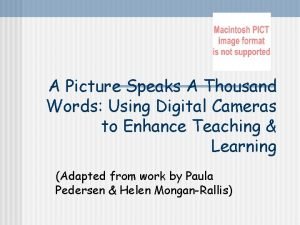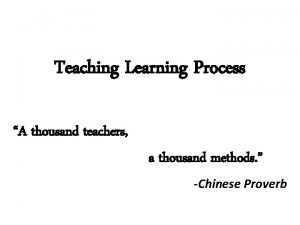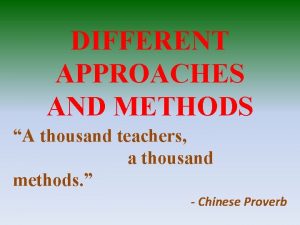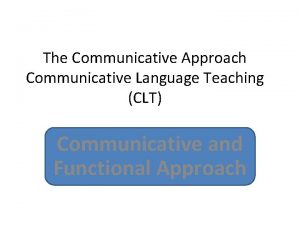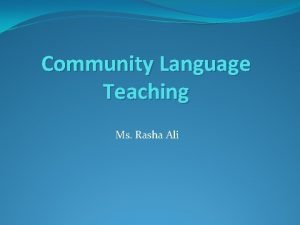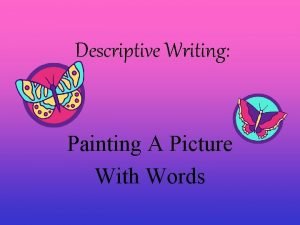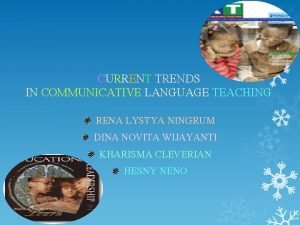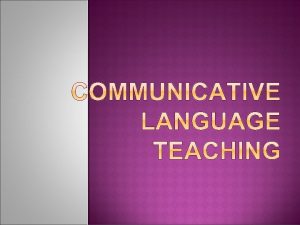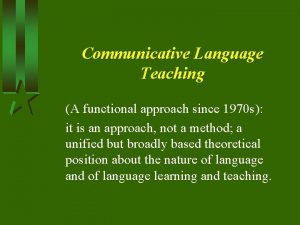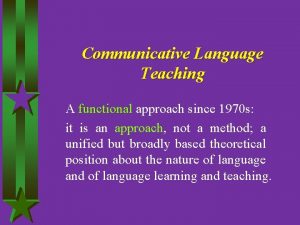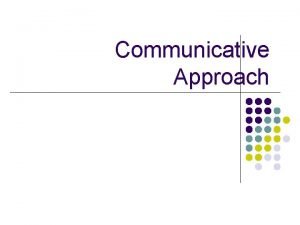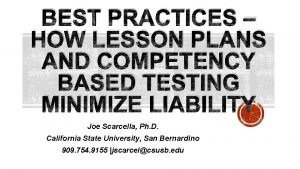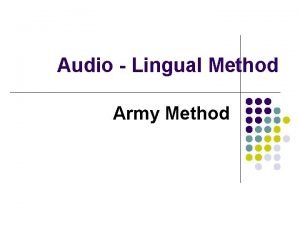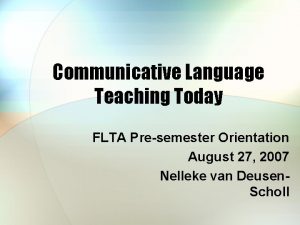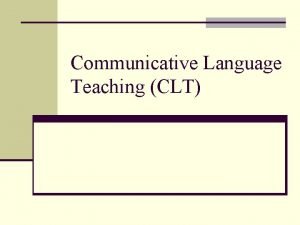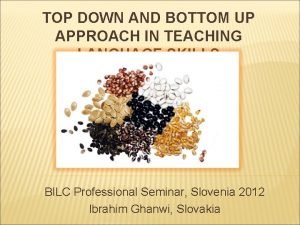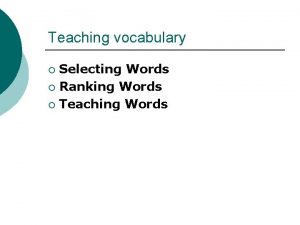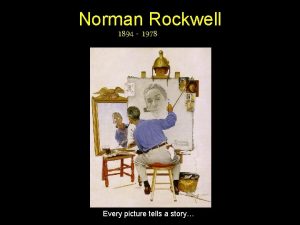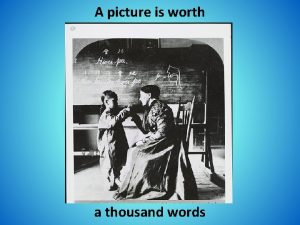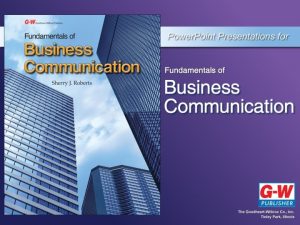Every Picture Tells a Thousand Words Teaching Language
















































- Slides: 48


Every Picture Tells a Thousand Words: Teaching Language and Culture through the Visual Arts BY: AMY E. LINGENFELTER SENIOR ENGLISH LANGUAGE FELLOW 2013 -15

Do You Agree or Disagree? Discuss in pairs the following statements: 1. I have used the visual arts (drawing, painting, photography, sculpture, etc. ) in my English classes before. 2. Having skills in the arts is not important in today’s society. 3. It is the teacher’s job to make learning fun. 4. Visual arts are fun for most children. 5. Every student learns in a different way 6. Students need to learn the same concept in different ways in order to retain information 7. Visual arts only works with young children (4 -10 years old) 8. Culture is best expressed through the arts

Quotes about the Arts: • “All religions, arts, and sciences are branches of the same tree” – Albert Einstein • “A great teacher is a great artist and teaching is the greatest of the arts since the medium is the human mind and spirit rather than the brush. ” – John Steinbeck • “Whoever neglects the arts after childhood has lost the past and is dead to the future” – Sophocles • “Art is not the imitation of life, it’s the manifestation and advancement of the human soul. ” – Me

Training Objectives: • Teachers (you!) will explore the benefits and the strategies to teach language and culture through visual arts activities and/or pre-existing works with an emphasis on communicative language teaching. • Teachers (you!) will learn how to apply these strategies and ideas to your own language classroom to: • Make English more fun and engaging • Maximize and encourage communication • Learn about English-speaking cultures!

Benefits of Using Visual Arts to Teach a Second Language: • Art and creativity are keys to cognitive growth and retention of information: • Art and creativity stimulates multiple parts of the brain, which leads to higher levels of retention • The key to learning and retaining information is making associations. Art helps students make them! • Art “kisses the brain!”

Benefits of Using Visual Arts to Teach a Second Language: Research about the brain suggests: • By instructing through multiple learning pathways, more “dendritic pathways of access” will be created. This can be achieved by absorbing formation through the 5 several senses (sight, sound, smell, touch, and taste) or by creating crosscurricular connections. • The more of these stimuli that are activated, the more impact the data has on the brain.

Benefits of Using Visual Arts to Teach a Second Language: • When more regions of the brain store data about a subject, there is more interconnection and cross-referencing of data from multiple storage areas in response to a single cue, meaning one has learned rather than memorized. ” – Wolfe, P. (2001).

Benefits of Using Visual Arts to Teach a Second Language: • It naturally and automatically incorporates multiple intelligences (Gardner, 1983)

Benefits of Using Visual Arts to Teach a Second Language: • It naturally and automatically incorporates multiple learning styles

Benefits of Using Visual Arts to Teach a Second Language: • It makes learning English fun! • It imitates, improves on, and makes more fun students’ real lives • It allows for creative and individual expression • It incorporates and accompanies all aspects of language and can be used to teach almost language point • It activates the spiritual, “unseen” side of students

Benefits of Using Visual Arts to Teach a Second Language: Students have the opportunity to… • Express themselves • Explore language and communicate freely • Explore feelings and find out about themselves and others • Develop cooperation, care, consideration and control • Develop language skills (listening reading, writing and speaking) • Explore a fantasy word of their own

Using Visual Arts to Teach English: “Every picture tells a thousand words”

Using Visual Arts to Teach English: “Every picture tells a thousand words”

Using Visual Arts to Teach English: “Every picture tells a thousand words”

Using Visual Arts to Teach English: “Every picture tells a thousand words”

Best Practices for Visual Arts: • Any work of art created or displayed in a language class should be used to practice, express, explain a language point: • Students create and explain their own art. • Teacher brings artistic images to the classroom for discussion. • Students analyze others’ works of art that are related to the topic of study in English and use an English language point to explain it. • Any medium works: murals, oil/acrylic paint, watercolors, pottery, drawings/ sketches, photography!

Best Practices for Visual Arts: • Images contextualize and illustrate English concept that is being taught and expressed • Summative presentation activity/art show finale is key! Students mount and present their work to others (presentation in English about their art using learned language points)

Best Practices for Visual Arts: Discuss in pairs: • Name at least 3 language points that could be taught through students creating their own artwork

Best Practices for Visual Arts: • Artwork can be used to teach a variety of grammar points and vocabulary, including but not limited to: • Colors, shapes, sizes • Locations • Prepositions of all kinds • Adjectives • Verbs (process, how to, commands, present progressive, past perfect, etc. ) • Vocabulary to name objects in artwork or class themes • Grammar of all kinds (“there is/are”)

Best Practices for Visual Arts: • Language mini-lessons prior to art activity work best • Art activity can later be used as a vehicle to: • Understand the process of HOW to complete the work • HOW to explain/describe their work (content, story behind it, etc. ) • HOW to communicate their process with classmates or teachers

Best Practices for Visual Arts: • Vocabulary: When you have students sketch something to illustrate what they’re learning, reading or writing, they make stronger associations and retain the information better! • For example, drawing an image that reminds students of the word’s meaning • Students must create art using that vocabularly and explain it in their presentation/show • Images can be used to depict/represent and teach almost any vocabulary word!!!


Best Practices for Visual Arts: • Themes of artwork can be based on students’ real lives and backgrounds • Artwork can be used to tell the students’ life story or an aspect of their life in English and utilize narrative story-telling: • One artwork or a series of works can be used to tell the story • Students can write a story/description based on someone else’s work (what they think it means) • Story can be oral, written, or both • Image can be accompanied by a written explanation/description in English • The possibilities for topics are endless!

Best Practices for Visual Arts: • Students can write and illustrate a fiction children’s book and read/demonstrate the story to the class or the community • Use images/art in language games: • Picture description • Guessing games • Classroom competition: best “guess” or story based on classmate’s artwork • Art Pictionary • “Draw a picture” game • Class murals/art project based on previously read text or to illustrate their own individual story

Integrating Culture: • Use pop art or famous works from Englishspeaking cultures as cultural analysis • Use art from different cultures to compare and contrast cultural charactersitics: • For example, busy American city life and concept of “time” as something to not be wasted vs. Colombia leisure time as highly valued • Students create art representing their own culture and compare it with art of other cultures (their “own version”).

Pilot Class: Refugees in Buffalo, NY:

Pilot Class: Refugees in Buffalo, NY: Class Description: • Refugee adolescent and adult students will simultaneously explore acrylic painting and learn English in a studio setting. Projects will be individualized, based on the goals and interests of the students, with a general common theme relating to their lives in their home countries and/or their current ones. • Painting techniques will be taught using the classic Baroque style and their paintings should be based on a photograph or realistic image of their choosing. Simultaneously, instructors will use class time to teach English vocabulary words, grammar, conversation skills, and presentation skills. Emphasis will be on oral and listening skills although instructors should also present language in written form. At the end of the class, students will be asked to present their painting to the

Pilot Class: Refugees in Buffalo, NY: Specifics: • Class Size: Around 15 students. This size is optimal for acquisition of both language and artistic skills and allows for more individualized instruction and opportunities to practice speaking English. • Age Range: Adolescents or adults ages 14 and up. We are focusing on older children and adults for this class because elementary-age refugee children have more opportunities for language-learning and art enrichment in the Buffalo public schools they likely attend. Older children and adults also have greater difficulty acquiring the phonetics, pronunciation, and in many cases the vocabulary of a second language; therefore, an additional language learning opportunity would be beneficial.

Pilot Class: Refugees in Buffalo, NY: Specifics: • Class Schedule/Timing: Once a week for 3 hours per session for a total of 7 weeks. This will allow most students to have at least one finished product by the end of the session and to give a presentation describing their painting. • The first 30 minutes of each class will include a minilesson of some aspect of the English language. • The following 20 -30 minutes will include a demonstration of a particular painting technique and/or art-related language instruction. The rest of the time will be devoted to painting and consultation, while the instructors continually advise students on an individual and as-needed basis. • Location: Buffalo Arts Studio, Tri. Main building, Buffalo, NY.

Pilot Class: Refugees in Buffalo, NY: Specifics: • Art Background/Proficiency: No prior art background or proficiency is required. Students may range from beginner to experienced, although there is a preference for students who have some experience with drawing and/or painting. Strong interest in painting is essential. • English Language Proficiency: Many refugee adults arrive in Buffalo with very little English language ability. For the first 7 -week session, we are proposing to recruit adults who are of beginning level with limited conversational ability. For the future, other levels may be incorporated. In addition to the language benefits, students will benefit from using art to express themselves in ways they are unable using English. • Instructors: One NY-State certified ESL (English as a Second Language) instructor and one NY-State certified

Pilot Class: Refugees in Buffalo, NY: Objectives: Students will be able to. . . • • Paint an image of something important to them from their home country, culture, religion, family, etc. OR their current one using acrylic on canvas and applying the classical Baroque technique. (It must be a subject that will lend itself to delivering a presentation with a culturally-based theme). Orally identify and/or define the following art-related content vocabulary: colors, tones, values, shapes, shadows, dark vs. light, blend, mix, soft edges, paint brush, etc. Deliver a 5 -10 minute presentation describing the colors, subjects, theme, setting/context, and story surrounding the painting to the class. Use descriptive adjectives (colors, physical attributes,

Pilot Class: Refugees in Buffalo, NY: Objectives: Students will be able to. . . • • • Use presentation skills and strategies to deliver a clear and convincing explanation of their painting. Use grammar “there is/are” and “there was/were” to describe their painting orally. Use the present simple tense and present progressive verb tenses to describe what is happening in their painting orally. (If applicable): Use the past simple tense and past progressive verb tenses to describe the past context of their painting orally. Comprehend the main idea of their classmates’ presentations. Listen to an oral description of a painting in the room given by an instructor and identify the painting the

Pilot Class: Refugees in Buffalo, NY: Objectives: Students will be able to. . . • Use questioning techniques, as well as vocabulary and grammar previously learned, to conduct an impromptu conversation with a partner about their partner’s painting. They must describe it using English they learned as well as the description their partner provided in his/her presentation. They must also ask their partner further questions about it. Their partner is expected to help clarify any inaccuracies in English.

Pilot Class: Refugees in Buffalo, NY: Assessment: • Informal Assessment (Speaking & Listening/Conversation): Each class will involve informal assessment of both English and artistic skills provided by both instructors on an individual, one-to-one, asneeded basis. The class will also allow for informal conversation in English between students from a variety of language and cultural backgrounds. All informal assessments will be conducted in English.

Pilot Class: Refugees in Buffalo, NY: • Formal Assessment (Speaking): At the conclusion of the 7 -week session, each student will deliver a presentation of his/her painting that depicts something important from their home country, culture, religion, family, etc. OR their current one using language previously learned (see “Class Objectives” above for more details). • Formal Assessment (Speaking and Listening): After listening to their classmates’ presentations of their paintings, each student will orally describe and/or ask questions about a randomly assigned partner’s painting using language previously learned and heard in the presentation. (This impromptu conversation is intended to evaluate students’ natural acquisition of the language as opposed to that which was planned or staged). The second listening assessment is the oral description of a painting in the group and identification of the painting

Pilot Class: Refugees in Buffalo, NY:

Using Visual Arts to Teach English: Let’s explore the ways that a student could use the following works of art to learn and practice English!

Using Visual Arts to Teach English: Let’s explore the ways that a student could use the following works of art to learn and practice English!

Using Visual Arts to Teach English: Let’s explore the ways that a student could use the following works of art to learn and practice English!

Using Visual Arts to Teach English: Let’s explore the ways that a student could use the following works of art to learn and practice English!

Using Visual Arts to Teach English: Let’s explore the ways that a student could use the following works of art to learn and practice English!

Using Visual Arts to Teach Culture: Let’s explore the ways that a student could use the following photos to learn English and other cultures!

Using Visual Arts to Teach Culture: Let’s explore the ways that a student could use the following photos to learn English and other cultures!

Using Visual Arts to Teach Culture: Let’s explore the ways that a student could use the following photos to learn English and other cultures!

Using Visual Arts to Teach Culture: Let’s explore the ways that a student could use the following photos to learn English and other cultures!

Using Visual Arts to Teach Language and Culture: Briefly brainstorm a lesson objective using art. Examples of Objectives: • Students will be able to (SWBAT)…. • Use descriptive adjectives (colors, physical attributes, personality characteristics, etc. ) to describe their painting to the class orally. • Use the present simple tense and present progressive verb tenses to write what is happening in their painting in a short paragraph. • Listen to an oral description of a painting in the room given by an instructor and, based on what he/she hears, identify the painting the instructor is referring to.

THE END! THANK YOU! • ANY QUESTIONS? • MY CONTACT INFO: • My Website: www. peopleleap. com (go to “Resources > “Downloadable Documents, Learning Links, Reading Links, and Teacher Links!”) • My email: utopia 747@gmail. com
 Every picture has a story and every story has a moment
Every picture has a story and every story has a moment Picture speaks a thousand words
Picture speaks a thousand words A picture is worth a thousand words examples
A picture is worth a thousand words examples Picture says a thousand words
Picture says a thousand words Storyworth alternative
Storyworth alternative A picture worth a thousand words meaning
A picture worth a thousand words meaning A thousand teachers a thousand methods explanation
A thousand teachers a thousand methods explanation Round 673 422 to the nearest hundred
Round 673 422 to the nearest hundred Indirect/guided/exploratory approach
Indirect/guided/exploratory approach Communicative approach شرح
Communicative approach شرح Picture strip story in communicative language teaching
Picture strip story in communicative language teaching 1 o clock
1 o clock Every nation and every country
Every nation and every country Microsoft mission and vision
Microsoft mission and vision Every knee shall bow every tongue confess
Every knee shall bow every tongue confess Every rotarian every year
Every rotarian every year Every nation and every country
Every nation and every country Every child every day
Every child every day Music that tells a story without words
Music that tells a story without words Words paint a thousand pictures
Words paint a thousand pictures This time this place misused mistakes figurative language
This time this place misused mistakes figurative language Microteaching is a scaled down teaching
Microteaching is a scaled down teaching Picture 1 picture 2
Picture 1 picture 2 Which grammar generates regular language?
Which grammar generates regular language? An essay that paints a picture with words
An essay that paints a picture with words Choose the words that describe the tv in the picture:
Choose the words that describe the tv in the picture: Translate picture words
Translate picture words Desuggestopedia principles
Desuggestopedia principles What is approach, method and technique
What is approach, method and technique Merits and demerits of direct method
Merits and demerits of direct method Lystya
Lystya Competency-based language teaching
Competency-based language teaching Language
Language Okanjo meaning
Okanjo meaning Communicative language teaching
Communicative language teaching Goals of clt
Goals of clt Competency based language teaching lesson plan
Competency based language teaching lesson plan Army method of teaching
Army method of teaching Aims of teaching foreign language
Aims of teaching foreign language The principles of interactive language teaching
The principles of interactive language teaching Language-based approach in teaching
Language-based approach in teaching Jenis evaluasi pendidikan
Jenis evaluasi pendidikan Going beyond the native speaker in language teaching
Going beyond the native speaker in language teaching Communicative language teaching today
Communicative language teaching today Background of clt
Background of clt Innovative methods of teaching english language
Innovative methods of teaching english language Top down approach teaching
Top down approach teaching Mondly delete account
Mondly delete account Competency based language teaching
Competency based language teaching

